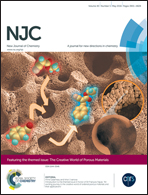A novel 8-hydroxyquinoline-pyrazole based highly sensitive and selective Al(iii) sensor in a purely aqueous medium with intracellular application: experimental and computational studies†
Abstract
A new 8-hydroxyquinoline-pyrazole based highly sensitive and selective Al3+ sensor, 8Q-NH-Pyz (H2L3), was found to exhibit a turn-on fluorescence enhancement (FE) as high as 157 fold with Kd = (1.76 ± 0.06) × 10−5 M. The 1 : 1 binding stoichiometry was revealed from the linear fit of (Fmax − F0)/(F − F0) vs. 1/[Al3+] of the fluorescence titration data which was further substantiated by Job's method and HRMS studies. The LOD determined by 3σ methods was found to be 4.29 nM and quantum yields were determined to be 0.002 and 0.28 for the ligand and its Al3+ complex, respectively. The tentative coordination environment in the [Al(L3)(H2O)]+ complex was delineated by DFT calculations. TDDFT calculations reveal spectral features comparable to the experimental ones. This constitutes the first report on the fluorescence sensing of Al3+ and hence F− in a purely aqueous medium.


 Please wait while we load your content...
Please wait while we load your content...